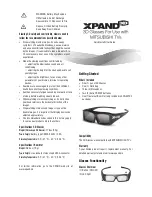
© XPAND, All Rights Reserved.
6
www.xpandvision.com
Connections
The ADe1512H should be mounted on the window frame in the projection booth near
the projector and an AC power outlet, in a position easily seen by the projectionist but
not such that it provides a distraction.
The power brick is plugged into a standard AC outlet and is connected to the
ADe1512H by a six foot DC power cable. The connection is made with a locking
connector to minimize the possibility of accidental disconnection.
Connection between the projector and the ADe1512H is made with a 10 foot
shielded multi-conductor cable. The end at the Projector is terminated by a male
DB37 connector. The termination at the ADe1512H is a female DB9 connector. Other
lengths can be fabricated onsite or specially ordered from XPAND.
The VeSA Frame Sync Standard calls for a TTL level square wave with a “TRUe” state
indicating a left eye image and a “FALSe” state indicating a right eye image. The
ADe1512H will respond properly to this signal. Today’s modern DLP projectors do
not supply such a signal. instead they provide access to an optocoupler which, when
supplied with a proper pull-up voltage and a suitable pull-down resistor, will generate
the TTL signal. The ADe1512H is equipped to handle this configuration.
The hardware is provided to mount the ADe1512H to a variety of surfaces. This
hardware should be bolted to a secure surface.
After mounting the ADe1512H, apply power. Activate the setup generator (Setup
Frame Sync) and, if desired, the laser pointer. Note that the presence of a frame sync
signal from the projector will inhibit the setup generator and the laser pointer. Next,
aim the ADe1512H at the screen. Aiming is not critical and can be done without aids,
but the laser pointer is included to facilitate aiming at small screens in large rooms.
The ADe1512H should be pointed at the center of the screen.
Recommendation: XPAND ONe is suitable for theaters up to 125 seats, but this should
be considered a limit. High gain screens give more iR reflection back into the center
of the audience, but can drop off significantly as one moves away from the center.
Low gain screens mean less reflection back in the center but more uniform reflection
throughout the theater.
UM-V14-1-ENG
061-0010-00
Summary of Contents for ONE ADE1512H
Page 2: ......
Page 7: ......
Page 8: ...to be used on dark background to be used on light background...















